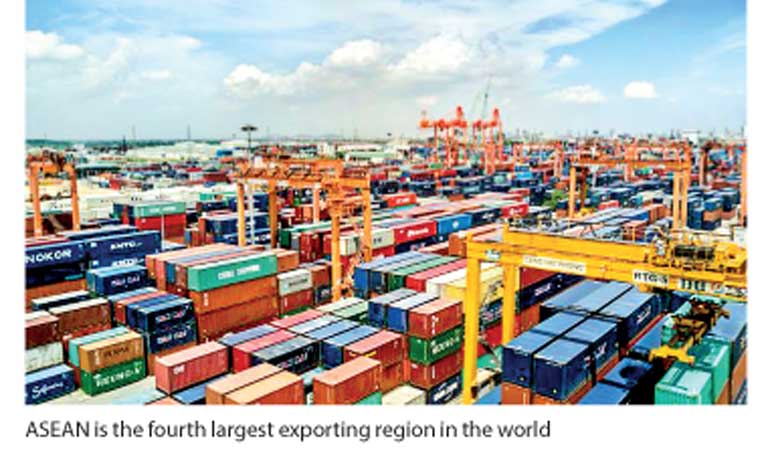Monday Jan 13, 2025
Monday Jan 13, 2025
Wednesday, 4 April 2018 00:00 - - {{hitsCtrl.values.hits}}
 By Jayant Menon
By Jayant Menon
blogs.adb.org: The importance of the Association of Southeast Asian Nations (ASEAN) in the broader region was highlighted again recently, when Australia convened the first Special Summit of Leaders in Sydney. There were even calls for Australia to join the grouping and become its eleventh member!
While all of this may point to ASEAN’s geopolitical and strategic importance, how has it fared economically?
Assessments of ASEAN as a regional integration endeavor often fail to separate the organisation’s underlying objectives from those that appear on the surface. Analysts assume, perhaps understandably, that the primary purpose of regional cooperation agreements is to increase regional integration.
If this were the case, traditional quantitative measures of integration—such as shares of intra-regional trade and investment—would be the right metrics for assessing performance.
On these metrics, ASEAN would be judged a failure. Intra-regional trade has remained low and stagnant at 25% for almost two decades.
Barely one-fifth of foreign direct investment (FDI) flowing into ASEAN countries originates from within the region. The regional share of other forms of capital flow has also stayed tepid.
But should ASEAN be judged this way? What if there are broader objectives being pursued? What if regionalism is only a means toward greater ends?
ASEAN is indeed pursuing broader objectives. The implementation of the ASEAN Free Trade Area (AFTA) provides a clear example. ASEAN’s original members used this agreement as a stepping-stone to broader liberalisation, and, in turn, to promote globalisation.
The evidence lies in the deliberate decision by original members to offer preferential tariff rates to non-members on a most favored nation (MFN) basis.
More than 90% of ASEAN countries’ tariff lines have a preference margin of zero, where preferential tariffs are no lower than the MFN rate. Over 70% of intra-ASEAN trade is also conducted at MFN rates at zero. ASEAN rarely uses preferences because there are hardly any preferences to use.
Multilateralisation of preferences has minimised trade diversion effects, and in part accounts for the stubbornly low intra-ASEAN trade shares. These are a sign of success, not failure.
Most intra-ASEAN trade is supply chain-related trade in parts and components. These parts mostly travel duty free because of product-specific arrangements such as the WTO’s Information Technology Agreement, or general ones like duty drawback schemes, bonded warehouses, or Special Economic Zone privileges.
The decision to multilateralise the AFTA tariff reductions have supported value chain-driven trade due to the fact that final markets for the finished goods lie predominantly in industrial country markets outside the region.
Though multilateralisation has subdued intra-regional trade, it has promoted rapid growth in overall trade. ASEAN is the fourth largest exporting region in the world, trailing only the European Union, North America and the People’s Republic of China.
Although ASEAN accounts for just 3.3% of global GDP, it produces more than 7% of exports. Trade volume and the terms of trade matter most for welfare, not with whom trade is conducted.
If intra-ASEAN trade is to increase in the future, it should be driven by factors other than preferences. Reducing non-tariff barriers (NTBs) in a non-discriminatory manner has potential to increase trade in services. For all services and increasingly goods as well, NTBs are the primary problem.
For goods, progress in tariff liberalisation has been offset by the rise in non-tariff impediments to trade, which increased from 1,634 to 5,975 between 2000 and 2015. This poses a new challenge for ASEAN.
NTBs are not only likely to be more restrictive than lower tariffs, but they are opaque and more difficult to dismantle. In addition, NTBs are a moving target because they can take on new forms as soon as they are targeted or dismantled.
While NTBs may be more difficult to identify, track and dismantle, this does not discount the effectiveness of the multilaterisation strategies. Unlike tariffs, it is either difficult or costly to exchange concessions in NTBs in a preferential manner, given the “public goods” nature of a lot of the reforms required and the consequent ease of free riding.
Whether it is tariffs or NTBs, the multilateralisation approach remains ASEAN’s best way forward.
In the original design of the ASEAN Investment Area, the bloc flirted with the idea of providing preferential treatment to investors from member countries. It however quickly abandoned the idea and reaffirmed its commitment to a non-discriminatory and open foreign investment climate, mirroring the regimes in individual member countries.
FDI inflows have flourished, even if intra-ASEAN flows remain little changed.
As with trade, it is not where FDI comes from that matters, but rather its volume and form. The massive economic transformations that the world has witnessed in ASEAN’s original member countries—and continues to observe in the newer members—would not have been possible if ASEAN had chosen the preferential route.
This is ASEAN’s defining achievement, and this is how it should be judged.
[The writer is the Lead Economist (Trade and Regional Cooperation), Economic Research and Regional Cooperation Department, ADB.]